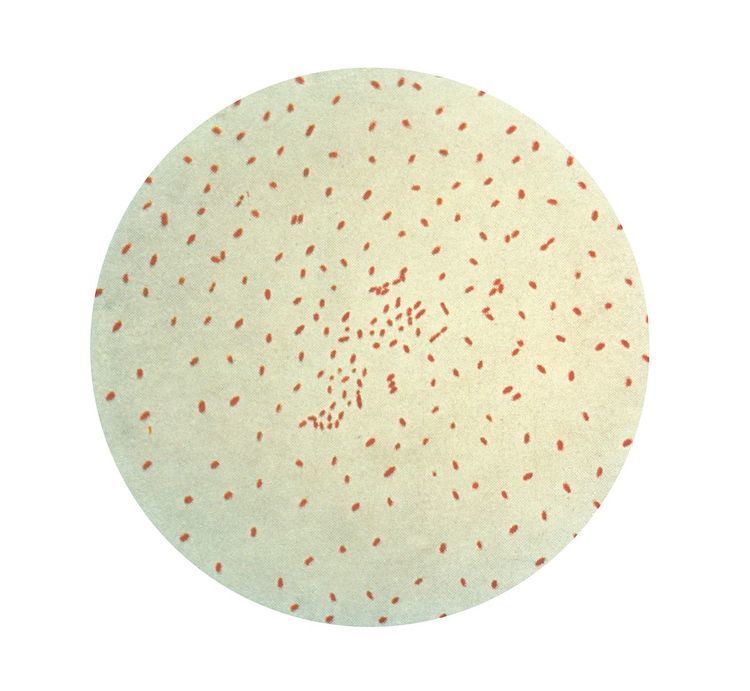Rank Species | Phylum Proteobacteria Family Alcaligenaceae Higher classification Bordetella | |
 | ||
Similar Bordetella, Bacteria, Bordetella parapertussis, Haemophilus, Neisseria | ||
Bordetella pertussis and whooping cough
Bordetella pertussis is a Gram-negative, aerobic, pathogenic, encapsulated coccobacillus of the genus Bordetella, and the causative agent of pertussis or whooping cough. Unlike B. bronchiseptica, B. pertussis is not motile. Its virulence factors include pertussis toxin, filamentous hæmagglutinin, pertactin, fimbria, and tracheal cytotoxin.
Contents
- Bordetella pertussis and whooping cough
- Bordetella pertussis
- Pertussis
- B pertussis as a zoonotic disease
- Diagnosis
- References
The bacterium is spread by airborne droplets; its incubation period is to human whooping cough in average 9–10 days (range 6–20 days). Humans are the only known reservoir for B. pertussis. The complete B. pertussis genome of 4,086,186 base pairs was published in 2003.
Bordetella pertussis
Pertussis
Pertussis (or whooping cough) is an infection of the respiratory system characterized by a “whooping” sound when the person breathes in. In the US, it killed between 10,000 and 20,000 people per year before a vaccine was available. Vaccination has transformed this; between 1985 and 1988, fewer than 100 children died from pertussis. Worldwide in 2000, according to the WHO, around 39 million people were infected annually and about 297,000 died. A graph is available showing the dramatic effect of introducing vaccination in England. B. pertussis infects its host by colonizing lung epithelial cells. The bacterium contains a surface protein, filamentous haemagglutinin adhesin, which binds to the sulfatides found on cilia of epithelial cells. Once anchored, the bacterium produces tracheal cytotoxin, which stops the cilia from beating. This prevents the cilia from clearing debris from the lungs, so the body responds by sending the host into a coughing fit. These coughs expel some bacteria into the air, which are free to infect other hosts.
B. pertussis has the ability to inhibit the function of the host's immune system. The toxin, known as pertussis toxin (or PTx), inhibits G protein coupling that regulates an adenylate cyclase-mediated conversion of ATP to cyclic AMP. The end result is phagocytes convert too much ATP to cyclic AMP, which can cause disturbances in cellular signaling mechanisms, and prevent phagocytes from correctly responding to an infection. PTx, formerly known as lymphocytosis-promoting factor, causes a decrease in the entry of lymphocytes into lymph nodes, which can lead to a condition known as lymphocytosis, with a complete lymphocyte count of over 4000/μl in adults or over 8000/μl in children. This is unique in that many bacterial infections illustrate neutrophil-predominance instead.
The infection occurs mostly in children under the age of one when they are unimmunized, or children with faded immunity, normally around the ages 11 through 18. The signs and symptoms are similar to a common cold: runny nose, sneezing, mild cough, and low-grade fever. The patient becomes most contagious during the catarrhal stage of infection, normally two weeks after the coughing begins. It may become airborne when the person coughs, sneezes, or laughs. Pertussis vaccine is part of the diphtheria, tetanus, and acellular pertussis (DTaP) immunization. The paroxysmal cough precedes a crowing inspiratory sound characteristic of pertussis. After a spell, the patient might make a “whooping” sound when breathing in, or may vomit. Adults have milder symptoms, such as prolonged coughing without the “whoop”. Infants less than six months also may not have the typical whoop. A coughing spell may last a minute or more, producing cyanosis, apnoea, and seizures. However, when not in a coughing fit, the patient does not experience trouble breathing. This is because B. pertussis inhibits the immune response, so very little mucus is generated in the lungs.
A prolonged cough may be irritating and sometimes a disabling cough may go undiagnosed in adults for many months.
B. pertussis as a zoonotic disease
Uncertainties of B. pertussis and whooping cough as a zoonotic disease have existed since around 1910, but in the 1930s, the bacteria were found to have lost their virulent power when repeatedly spread on agar media. This explained the difficulties in reproducing results from different studies, as the preinoculating handling of the bacteria were not standardized among scientists.
At least some primate species are highly sensitive to B. pertussis, and develop a clinical whooping cough in high incidence when exposed to low inoculation doses. Whether the bacteria spread naturally in wild animal populations is not satisfactory confirmed by laboratory diagnosis, but whooping cough has been found among wild gorillas. Several zoos have learned to vaccinate their primates against whooping cough.
Diagnosis
A nasopharyngeal or an oropharynx swab is sent to the bacteriology laboratory for Gram stain (Gram-negative, coccobacilli, diplococci arrangement), growth on Bordet-Gengou agar or BCYE plate with added cephalosporin to select for the organism, which shows mercury drop-like colonies.
Several diagnostic tests are available, especially ELISA kits. These are designed to detect FHA and/or PT antibodies of IgG, IgA, or IgM. Some kits use a combination of antigens which lead to a higher sensitivity, but might also make the interpretation of the results harder, since one cannot know which antibody has been detected. Also, a new rapid molecular test is available, real-time PCR, based on the so-called FilmArray technology . This test takes about one hour and detects about 15–17 viruses and bacteria, including B. pertussis.
The organism is oxidase positive, but urease, nitrate reductase, and citrate negative. It is also not motile.
